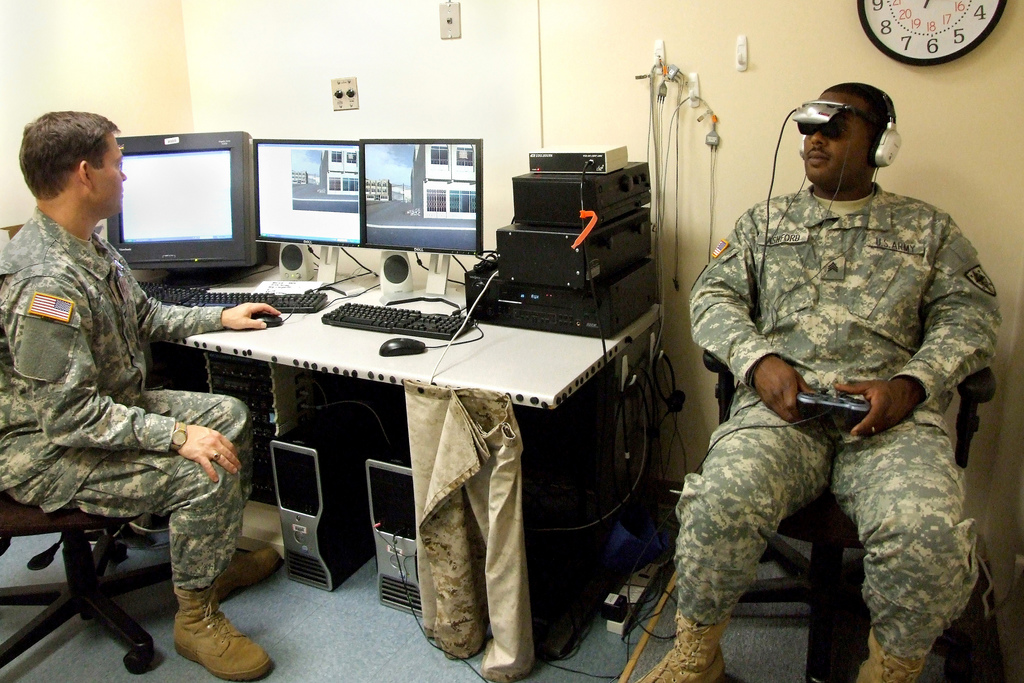Virtual Therapy Environments: leveraging new technologies to treat wounded warriors
The policy proposal discussed in this article, from Dr. Charles Levy, was a finalist in Pioneer’s 2016 Better Government Competition.
Over the last fifteen years, the U.S. has coordinated an enormous mobilization of U.S. military personnel to Iraq and Afghanistan—over 1.5 million members of the service have been deployed to these countries since 2001. As American soldiers have returned from their tours of duty, overwhelming evidence has confirmed the pervasive extent of post-traumatic stress disorder (PTSD), mild traumatic brain injury (mTBI) and other mental health conditions affecting memory, concentration and emotional control. The ravages of modern warfare have increased the prevalence of these illnesses, as improvised explosive devices and other features of today’s battlefields have increased the incidence of combat-related blast injuries by 88-97 percent. Although moderate and severe traumatic head injuries are easily identified and aggressively treated, mild TBI (mTBI)–which makes up 75 to 90% of all TBIs–often goes unrecognized, even as the affected individuals lose employment and relationships.
Many veterans with mTBI/PTSD exhibit difficulty with basic tasks. Their heightened sense and awareness of risk – honed in warfare – make adjustment to civilian settings extraordinarily difficult. This commonly manifests in violent outbursts toward others perceived to be a threat and overprotectiveness of family members, along with extreme anxiety and cognitive difficulty.
In 2011 alone, more than 33,000 American veterans and active soldiers were diagnosed with TBI, and cost projections for their care continue to soar. The Veterans Health Administration (VHA), which provides care to eligible veterans, has the seemingly impossible task of serving these veterans wherever they are, with the highest quality of care. This challenge has become one of the major mental health issues of our time.
A multitude of barriers must be breached to deliver needed care The culture among soldiers and veterans often discourages face-to-face therapy in traditional brick and mortar settings as a sign of weakness. Distrust and skepticism of government institutions may also play a role. There are also issues with physical access—for veterans living in rural areas far from VA healthcare providers, the frequent visits required for long-term therapy may not be practical.
The unprecedented number of active military personnel and veterans in need of proper care for these health issues demands dynamic and scalable solutions. An especially promising initiative in this space is being developed by Dr. Charles Levy, a researcher and Chief of Physical Medicine and Rehabilitation at the North Florida/South Georgia Veterans Health System, and his collaborators within the VA and at the University of Florida. Building on years of work made possible by a research grant from the VA’s Office of Rehabilitation Research and Development, Levy and his team are building a novel virtual reality (VR) application designed to treat wounded warriors and others suffering from mTBI/PTSD.
Dr. Levy’s program places veterans in a Virtual Reality Environment (VE). VEs are computer-generated simulations of real-life (or imaginary) settings that facilitate immersion and interactions in a controlled and secure environment. A patient using VE can interact with Virtual Humans (VH), which are sophisticated and specialized digital replications of human beings that populate VEs. Levy’s VHs are designed to help veterans in their re-adjustment to civilian life by “presenting social challenges, exploring attitudes and beliefs, and teaching social strategies and coping mechanisms”.
Dr. Levy’s team has developed an especially innovative model employing these technologies: a virtual grocery store—“V-Mart”—where patients encounter a range of situations and stimuli that challenge the symptoms of their mTBI/PTSD. For instance, an infant may cry out randomly, a cashier might become unacceptably rude, or the change given could be wrong. These stimuli can be adjusted by the clinician according to a patient’s needs and progress. In V-Mart’s controlled simulation, the individual is free to make mistakes and even get upset, without risking adverse consequences, as opposed to the real world, where a violent outburst at a cashier could generate at the least awkward, and in some instances, devastating outcomes. Levy is convinced that with repeated exposure, the individual will re-learn how to navigate civilian life.
The V-Mart experience is controlled by a therapist, who determines the challenges the veteran encounters in the store, and who is available to guide the veteran through the experience. Another feature of Levy’s strategy is to make V-Mart accessible on the Web, through live streaming tele-video. Secure, encrypted VA enterprise networks exist that could enable veterans at home to connect with the therapist at work, and simultaneously in V-Mart. This would expand access to rural and disabled veterans.
This application of VR is in accordance with the 10 strategies listed in the VA’s Blueprint for Excellence, which delineates standards for health and well-being. A number of focus groups of Veterans and therapists have been completed to assess the value and utility of V-Mart—all have shown promising results for future applications of this model. The Systems Usability Scale (SUS), a measuring tool to determine the usability of a treatment on a 100-point scale, was used to assess the usefulness and realistic benefit such a platform could have for wounded warriors. The results showed increasing value with successive iterations of the store. There was a unanimous consensus on the positive potential V-Mart offers.
Dr. Levy’s team has put together an innovative proposal to treat wounded warriors with cutting-edge technology and analytics with promise to strengthen cognition and emotional control among patients to facilitate community integration. While initial findings are encouraging, more research is needed into the medical applications of this very new field. Policymakers should recognize the value of VR treatments—and tele-medicine generally—and encourage continuing research to confirm the utility of VR applications for treatment purposes. The VA should continue to support and expand Dr. Levy’s virtual reality program to cover more and more detailed situations, to further research this new technology’s potential in helping victims of mTBI/PTSD lead normal lives.




Leave a Reply
Want to join the discussion?Feel free to contribute!